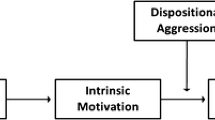Abstract
In recent years destructive deviant behavior in organizations has drawn increasing attention. However, surprisingly little work has been devoted to assessing when the economic value of deviant behavior is tolerable (i.e., the benefits from employing the deviant worker exceed the financial costs of his/her deviance) and when it becomes unbearable (i.e., the financial cost of the deviance exceeds the benefits accrued from his/her employment). The purpose of the present paper is to introduce a mathematical model which may resolve this lacuna. In addition, a simulation was conducted and its results were reported in order to illustrate the usefulness of the proposed mathematical model. In conclusion it is suggested that the present model be further examined empirically in the real workplace.
Similar content being viewed by others
References
Barberis N., Huang M., Santos T.: Prospect theory and asset prices. Q. J. Econ. 116, 1–53 (2001)
Berry C.M., Ones D.S., Sackett P.R.: Interpersonal deviance, organizational deviance, and their common correlates: a review and meta-analysis. J. Appl. Psychol. 92, 410–424 (2007)
Coffin B.: Breaking the silence on white collar crime. Risk Manag. 50, 8 (2003)
Cohen-Charagh Y., Mueller J.S.: Does perceived unfairness exacerbate or mitigate interpersonal counterproductive work behaviors. J. Psychol. 92, 666–680 (2007)
Dilchert S., Ones Davis R.D., Rostow J.D.: Cognitive ability predicts objectively measured counterproductive work behaviors. J. Appl. Psychol. 92, 616–627 (2007)
Griffin R.W., O’Leary A.M., Collins J.: Dysfunctional work behaviors in organizations. In: Cooper, C.L., Rousseau, D.M. (eds) Trends in Organizational Behaviors, pp. 65–82. Wiley, New York (1998)
Kahneman D., Tversky A.: Prospect theory: an analysis of decision under risk. Econometrica 47, 263–291 (1979)
O’Leary-Kelly A.M., Griffin R.W., Glew D.J.: Organization-motivated aggression: a research framework. Acad. Manag. Rev. 21, 225–253 (1996)
Robinson S.L., Bennett R.B.: A typology of deviant workplace behaviors: a multi-dimensional scaling study. Acad. Manag. J. 38, 72–555 (1995)
Tziner A., Birati A.: Assessing employee turnover costs: a revised approach. Hum. Resour. Manag. Rev. 6, 113–122 (1996)
Tversky A., Kahneman D.: Advances in prospect theory: cumulative representation of uncertainty. J. Risk Uncertain. 5, 297–323 (1992)
Author information
Authors and Affiliations
Corresponding author
Rights and permissions
About this article
Cite this article
Levy, T., Tziner, A. When destructive deviance in the workplace becomes a liability: a decisional behavioral model. Qual Quant 45, 233–239 (2011). https://doi.org/10.1007/s11135-009-9277-0
Published:
Issue Date:
DOI: https://doi.org/10.1007/s11135-009-9277-0




